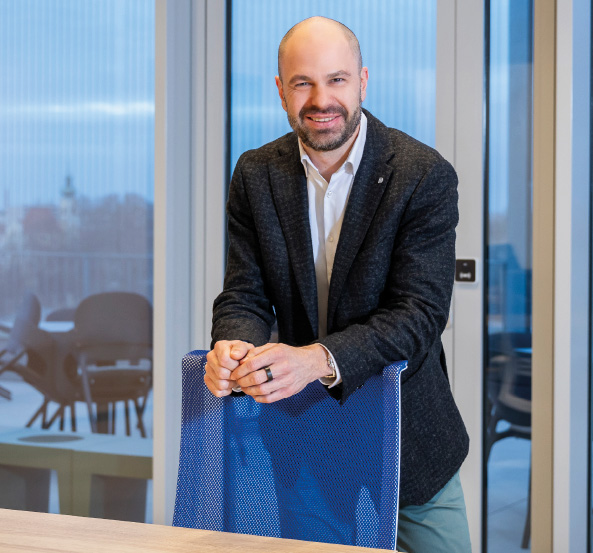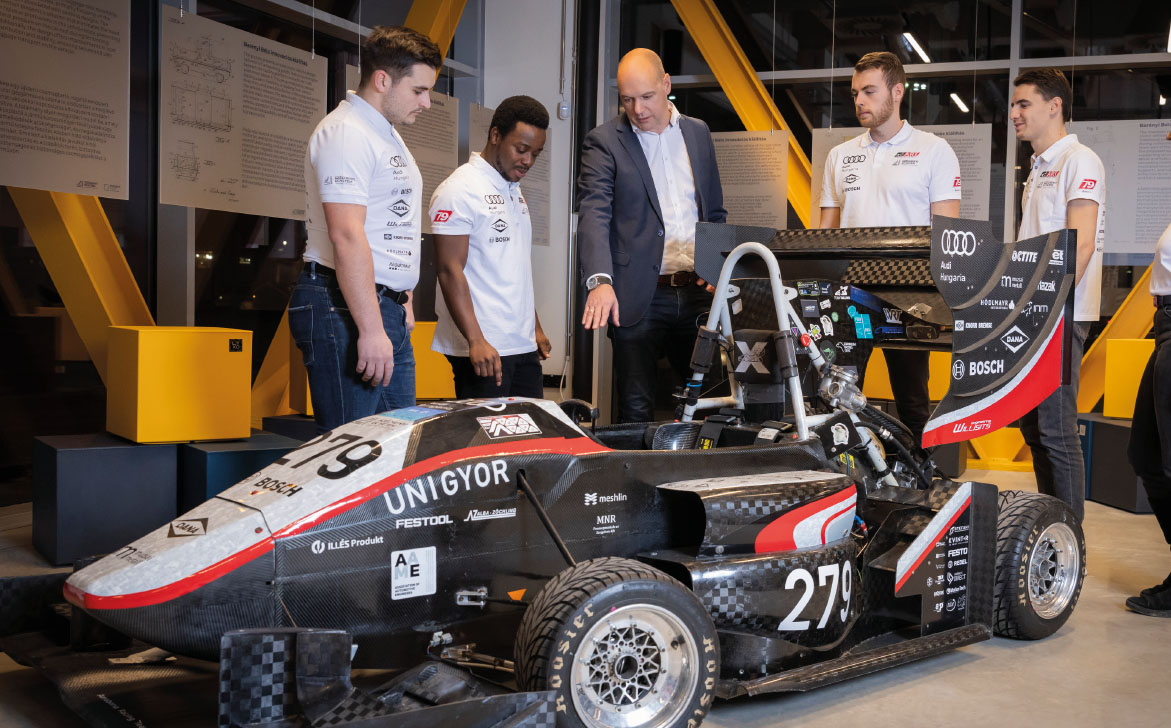
An innovative ecosystem built on
a comprehensive training spectrum
Social responsibility in education. This is a priority area for Audi Hungaria: we believe that, in our industry, it is essential to play a role in educating young people and provide practice-oriented training. We are pioneers in this field, and have developed a genuine training matrix. Below, through two unique university research partnerships, we explain how this structure works.
Numerous German businesses operate in the region where we are based. Audi Hungaria has built and now supports an education system which functions as an intersection of culture exchange, the needs of the economy and the individual’s chosen career path. What does this system offer, exactly? Kata Németh guides us through the innovation and education ecosystem, while Zoltán Kocsis presents the benefits of specialist training.
Audi Hungaria School Centre: from preschool to high school final exams and beyond
The institution was founded as a place where German and Hungarian cultures meet in order to provide a home for intercultural and bilingual education. It has also created a valuable cross-cultural and methodological framework that helps ensure the highest level of education. Firstly, the school provides outstanding professional and language training that open the doors to Hungarian and international schools and higher education. Thanks to qualifications certified in both Hungary and Germany, the institute can also support (re)integration between the two countries. Thirdly, the Audi Hungaria School Centre is a meeting place for cultures and therefore an important promoter of internationality. Step by step, the Audi Hungaria School Centre has now reached a point where it can provide an educational and learning platform for students aged 3 to 20. Of the 135 international German schools in the world, it is one of the few to have received the excellent (Excellente Deutsche Auslandsschule) rating. It is also one of the top foundation-run schools in Hungary. A total of 850 children and young adults learn in this experience-based, practice-centred and supportive environment. Its high school graduates are able to begin their adult lives with a dual German and Hungarian final exam certificate and excellent language skills.
What happens after graduating high school?
The young students can pursue a vocational course for a further two years. This is also held at the Audi Hungaria School Centre, but under a dual training system that is even more practice-orientated. In the industrial and commercial technical training, which is designed in line with the German structure, in addition to the school curriculum, students also acquire effective knowledge related to the company’s activities. This enables them to gain experience appropriate to their education in a business environment and with practical examples. At the end of the course, they will receive a Hungarian and German professional certificate modelled on the German dual secondary education system, and will be able to start a career with extensive knowledge at their command.
The dual vocational training began as a pilot project, and was then institutionalised. It is the same for any of our initiatives – by investing a huge amount of effort, starting with a clean slate and without any revious history, we have been able to create new study opportunities.
This is also true of, for example, our partnerships with the Győr Vocational Centre, the Győr-Moson-Sopron County Chamber of Commerce and Industry, and the Ministry of Culture and Innovation. As a dual training partner we are involved in school-based education, in the development of training programmes and in the formulation of common goals on a daily basis. But if we take a broader view, we have also had to bring a new approach in terms of access between secondary and higher education. This is why the contents of the certified technical training can count as credits at the university level. The Győr Knowledge Transfer Centre was established with the cooperation of the stakeholders to share positive experiences and shape the modern educational environment in line with the current needs of the labour market.
It is essential to have higher education programmes with a project-based approach and based on genuine practical foundations. Since 2015, our specialist areas at Audi Hungaria have welcomed and trained close to 50 dual students a year. In addition, for those of our colleagues who have many years of industrial experience coupled with academic interests, the company can provide unique development paths to encourage the expansion of future strategic areas of competence, as well as a special advancement program.
A complex approach
Our mission in education is outlined in our corporate strategy: to build an innovation
ecosystem that creates dialogue, cooperation and frameworks for implementation between industry,
academic stakeholders and related institutions.
Highlight: lifelong learning
The essence of our education system is for our students and our employees to be able to develop professionally or advance to a higher level at any point of their life and career – this means we can provide everyone with the opportunity to learn. Individuals might be motivated by an inner urge or professional expectations, and their education can extend to adult training, retraining, professional competencies or even the development of soft skills. The company has also been supporting internal professional and non-professional further training with the portfolio of the Audi Academy, as well as numerous external training courses through study contracts for many years.
Reforms in real time:
training courses in higher education
In 2014, together with Széchenyi István University, Audi Hungaria created the unique Faculty of Automotive Engineering, as well as research studies, academic subjects, a dual training programme, and a research partnership for participants in higher education. As a result, today 65–70% of our engineers, economists and logistics experts come from Széchenyi István University, and a total of 80% come from one of our partner universities.
We also have numerous colleagues with university degrees who nevertheless still need to acquire new skills. For example, we would like to have IT experts who can master the necessary understanding of SAP in a shorter-than-average time period in order to meet the needs of a new business segment. Here, we can turn to Audi Hungaria’s internal training system. And if we don’t find the right alternative there, we can create new, shorter training programmes in partnership with universities that can enhance existing adult education.
Innovative mission
Our joint partnerships with higher education and science focus on research, development and innovation, based on practice-orientated education. One vital mission is to ensure that our young professionals and other colleagues are able to change, develop, innovate, question and find solutions, in addition to providing professional content, of course.
We support the efforts of our partner institutions to become more international and improve their visibility and perception, such as through the joint development projects of the Formula Student student development teams and the Audi Development Camp student bootcamp. Our collaborations with academic and educational institutions enable our colleagues to sit at the same table with other experts and formulate questions and solution strategies in the framework of continuous cooperation, either for industry proposals, in the field of training, or business innovation projects that generate income for both the university and the company.

Our joint partnerships with higher education and science
focus on research, development and innovation, based on
practice-oriented education.

In secondary education, we are currently working with five partner schools
across 11 fields of expertise. In higher education,
we have several domestic partner universities. Our diverse
partnership portfolio with Széchenyi István University in Győr
in the areas of education, research and development, and innovation projects is of particular importance.

The future of hydrogen and the carbon cycle
Our company is working with not only Széchenyi István University and the University of Szeged on several promising projects, but also the former Ministry of Innovation and Technology and the Ministry of Energy. While universities approach topics from an academic perspective, at Audi Hungaria we think in terms of models applicable to industry. These partnerships are fruitful for both parties. Here are two examples:

Head of Project Management Powertrain

One of the main areas that we are currently working on is the use of hydrogen as an energy source in an industrial environment. Here, we produce hydrogen and oxygen by splitting water with the help of an electrolyser. The focus is on how we can extract the energy stored in it in the best way for the company. As project manager Tobias Attensperger explains, while Széchenyi István University focuses on the technology of green hydrogen produced using 100% renewable energy, we are motivated by the need for CO2 neutrality and achieving independence from the global energy crisis.
Another significant part of our work also focuses on CO2. :As part of this project, we have installed a DAC filter (Direct Air Capturing device) that can extract emitted carbon dioxide from the air. This will initially be used for growing plants in greenhouses, but we are also investigating the possibilities of underground storage that would actively reduce the CO2 content of the air. CO2 can also be used in artificial fuels (e.g. e-methane, e-fuels, e-methanol, etc.), which results in a carbon dioxide cycle. Testing and analysis of the effect of artificial and bioregenerative fuels on our engines is being done within the framework of this cooperation as well. Furthermore, we are also working on using artificial intelligence to detect carbon dioxide emissions as they appear. Based on the data obtained, we could subsequently reduce or completely eliminate these sources.

Acoustics in virtual simulations
At the Audi Hungaria Faculty of Automotive Engineering, we are involved in both training and research and development: As part of the recently concluded Momentum program, which is funded jointly by the Hungarian Academy of Sciences and Audi Hungaria, we developed new vehicle acoustic simulation methods with four young researchers. Three of the students began working in the Vehicle Development department of Audi Hungaria after finishing their doctoral studies, while the fourth remained in the academic department as a researcher, explains department head Dr Dániel Feszty, who is also a director in Vehicle Development.
Uniquely among vehicle factories in Central and Eastern Europe, Audi Hungaria has a major Technical Development division in Hungary. The Faculty of Vehicle Development at Széchenyi István University in Győr, founded just ten years ago by Audi Hungaria, is designed to support the related training and research and development activities. The faculty predominantly deals with methodological developments that support virtual vehicle development, i.e. with the development of solutions that enable the replacement of experiment-based development processes with computer simulations. This makes the vehicle development processes faster, cheaper and more accurate – an important indicator of competitiveness.

While universities approach topics from an academic perspective, at Audi Hungaria
we think in terms of economically viable models
that can be applied in industry.

Dr Dániel Feszty
Head of the Department of Vehicle Development, Academic Director, university professor
Faculty of Vehicle Development
Audi Hungaria Faculty of Automotive Engineering
Dániel illustrates this through an acoustics-related example: “In some cars, as much as 20-30% of the driving or passenger experience is defined by the interior noise. This is why internal acoustics is one of the most important qualities in a vehicle.” One of the great challenges in vehicle development is to ensure that the customer encounters the right Audi sound, whether with a classic internal combustion engine or an electric motor. “Our research led us to set up a laboratory – the only one in the region – for measuring Biot parameters. These can be used to determine the input data required for acoustic simulations,” Dániel explained. Biot parameters express the noise-absorbing ability of the upholstery in the passenger compartment of vehicles. “Precisely performing the measurements requires in-depth expert and scientific knowledge, and is so novel that many aspects of it are currently the subject of research. In cooperation with Audi Hungaria, we deliver this kind of measurement data to the various brands of the Volkswagen Group in order to support our company’s state-of-the-art development processes.”
